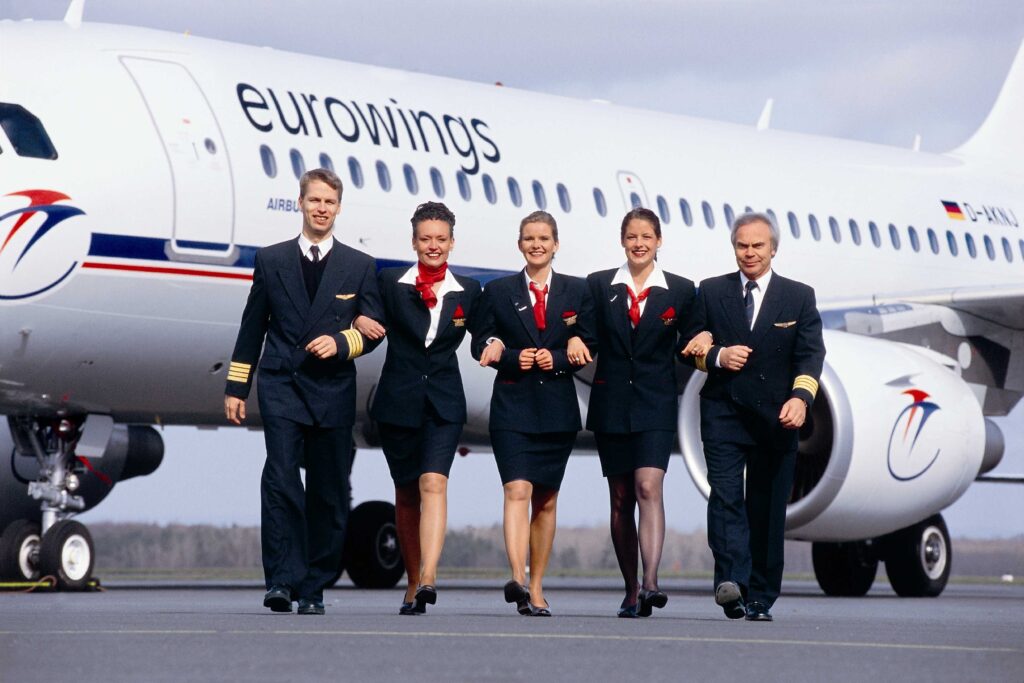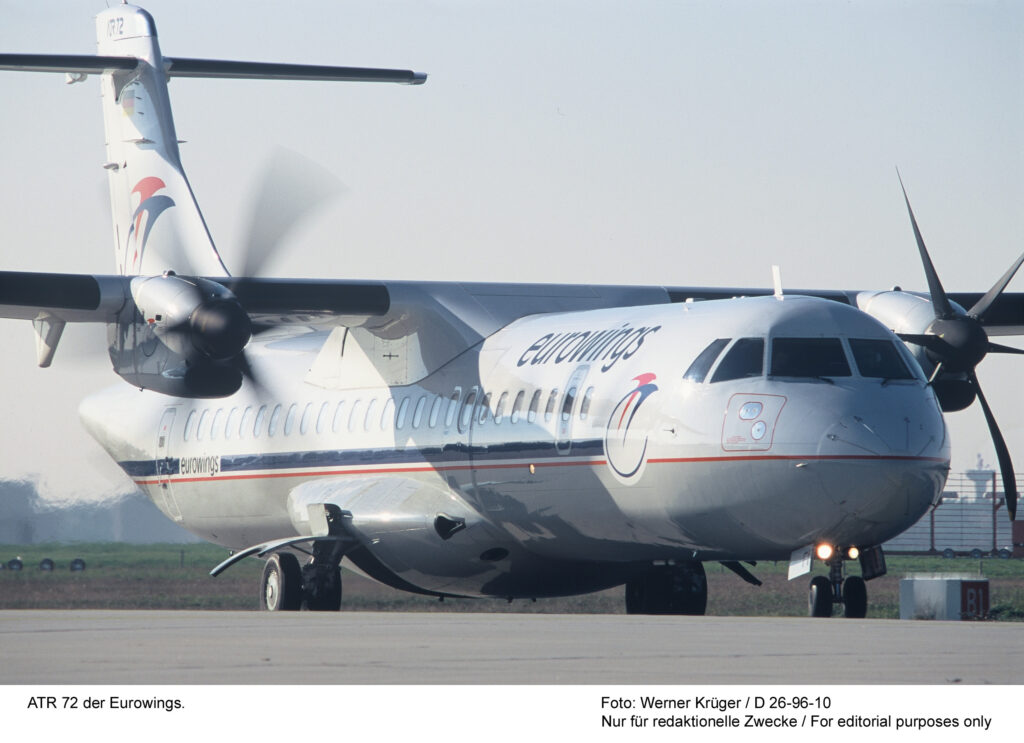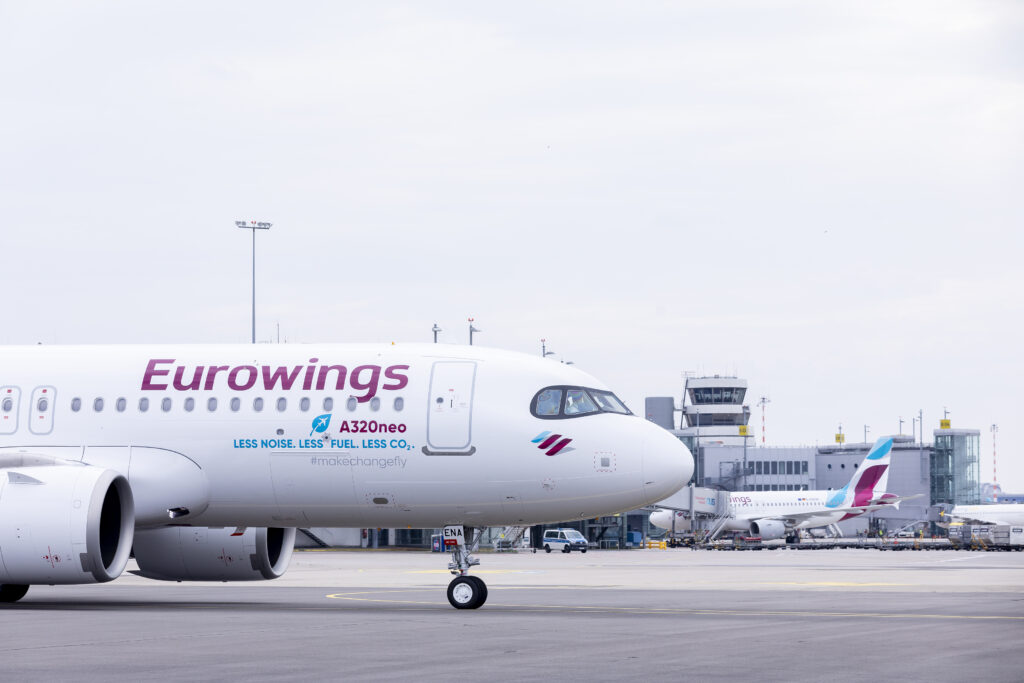Eurowings’ journey from “air taxi” to value airline for Europe

Today’s Eurowings was formed on 1 February 1993 from the merger of the two regional airlines. The mid-1970s, two pilots, one dream. Independently of each other, Hans Rudolf Wöhrl founds Nürnberger Flugdienst (NFD) and Reinhard Santner founds Dortmund Reise- und Industrieflug (RFG). The portfolio of the two companies is similar and includes air taxi services, ambulance and cargo flights, seaside resort services – so-called on-demand air transport. The name “Eurowings” was suggested by an employee who won an ideas competition with 500 Deutsche Mark for the winning entry. The logo introduced in the course of the launch was designed by students of the Nuremberg Academy of Arts.
Take-off with propeller aircraft
At that time, the airline started with just under 1,000 employees and ATR 72 propeller aircraft. Although 32 destinations in eleven countries were already served in the founding year, the focus was on domestic connections. For quite some time, Eurowings had to fly under the flight numbers of NFD and RFG, because the code that Eurowings needed had been assigned by the International Air Transport Association (IATA) to a subsidiary of Papua New Guinea-based Janlyn PTE. Through intensive negotiations, it was finally possible to get the EW code for Eurowings’ flights. The first flight, with the number EW733, went from Nuremberg to Paris in 1994. In the 1990s, Eurowings took over feeder flights for the Dutch airline KLM, among others, and was en route to Amsterdam with 13 aircraft at times – initially as a competitor of Lufthansa.

2001: Lufthansa acquires a stake in Eurowings
The year 2001 marks a milestone in the history of Eurowings. With the Lufthansa Group’s participation, the company’s strategy changes: the turboprop aircraft are replaced by CRJ jets, and Eurowings operates flights in the Lufthansa Regional network.
Just one year later, Eurowings launches a low-cost pioneer for Germany, Germanwings, which, in tandem with Eurowings, soon breaks the 10-million passenger mark. The great era of low-cost airlines begins (slogan: “Fly high, pay low”), to which Germanwings contributes the flexible fare model BASIC, SMART and BIZclass. The concept quickly becomes the industry standard and is still used at Eurowings today. In 2011, Eurowings moves to Düsseldorf, the largest air traffic location in North Rhine-Westphalia.
“Light Sky Blue” and “Burgundy”: Eurowings’ leading colors since 2014
In 2014, the company gets the look and brand identity it is known for today, with the leading colors “Light Sky Blue” and “Burgundy”. The new strategy includes, among other things, a significant expansion of Germanwings and Eurowings in line with growing travel: the previous Eurowings fleet of smaller CRJ aircraft will be replaced by 23 aircraft from the Airbus A320 family.

Inseparably linked to the company’s history, however, is the accident of Germanwings flight 4U9525 on 24 March 2015, which claimed the lives of 150 people. An event that will remain in collective memory forever.
Eurowings subsequently begins to expand away from German airports, soon opening a base on Mallorca and founding the Eurowings Europe flight operation for pan-European routes outside Germany. And the dynamic development continues: after the end of Air Berlin in 2017 and the takeover of a large part of the fleet, hundreds of new jobs are created – many of which are filled by former AirBerlin colleagues.
Eurowings today: the value airline for Europe
Today, Eurowings explicitly sets itself apart from the ultra-low-cost carrier segment with its clear positioning as Europe’s value carrier for private and business travelers. The Lufthansa subsidiary combines inexpensive and flexible flying with innovative and customer-friendly services – a strategy with which it is expanding its leading position in the German market. In doing so, it focuses on the core needs of today’s air travelers: more flexibility, affordable comfort and sustainability.

“There are very few airlines in Germany that have succeeded for 30 years in a difficult market environment and have repeatedly mastered dynamic changes. It is all the more wonderful that we can celebrate our 30th birthday as Germany’s largest holiday airline,” said Eurowings CEO Jens Bischof. “We owe this success first and foremost to our more than 4,000 employees from 60 nations who have found their professional home with us. This diversity makes us strong. Because what has always distinguished Eurowings is the very special team spirit and the ability to react quickly to ever new market changes. We say thank you, Team Eurowings – here’s to the next 30 years!”
The Eurowings fleet includes more than 100 aircraft that fly to 140 destinations in more than 50 countries. In addition to its bases in Cologne/Bonn, Düsseldorf, Hamburg, Stuttgart and Berlin, Eurowings also has major operations in Palma de Mallorca, Salzburg, Prague and Stockholm. This makes the Lufthansa subsidiary one of the largest leisure airlines in Europe. Every minute, a Eurowings aircraft takes off or lands somewhere in Europe.

Focus on sustainability
Eurowings combines its passion for flying with corporate responsibility for the environment. It aims to cut its carbon emissions in half by 2030 and achieve carbon neutrality by 2050. An important step towards this was the introduction of the world’s most efficient medium-haul jet, the Airbus A320neo, into the fleet in 2022. Each new aircraft of this type emits 4,500 tonnes less CO2 per year compared to its predecessor. In addition to this, more than 50 projects with the aim of conserving resources and protecting the environment are underway at Eurowings.
Carbon compensation at the click of a mouse, punctual flights, friendly services, the most flexible rebooking options in the industry or a free middle seat starting at ten euros – these are just a few of the many examples of the modern value concept with which Eurowings presents itself as young, modern and innovative, even after 30 years.


Comments are closed.